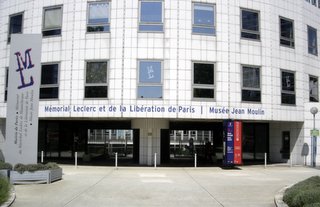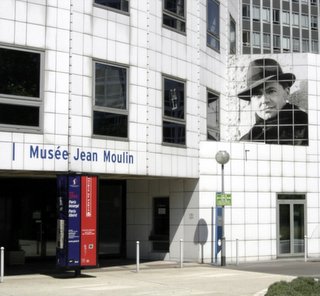Memorial of the Liberation of Paris
A Must-See For WWII Historians

Memorial of the Liberation of Paris
Metro: Montparnasse Bienvenüe
Arrondissement: 15eme, Allée de la 2e Division Blindée
Go Here For Hotels In This Area
Map of the Area
The Memorial of the Liberation of Paris is located next to the Jardin Atlantique, both are on the roof of the Montparnasse train station, Gare Montparnasse. The Memorial is also known as le Mémorial du Maréchal Leclerc de Hauteclocque et de la Libération de Paris - Musée Jean Moulin.
The Mémorial du Maréchal Leclerc de Hauteclocque et de la Libération de Paris - Musée Jean Moulin, the Memorial of Marshal Leclerc de Hauteclocque and of the Liberation of Paris - Museum Jean Moulin, was inaugurated by the Mayor of Paris, Jacques Chirac, on August 24, 1994, on the 50th anniversary of the liberation of Paris from German Occupation of WWII.
General Maréchal Leclerc (1902-1947) was a French Commander who fought in North Africa. Returning to France, he led the 2nd Armored Division, with the support of the 4th Division of the American Infantry, to the liberation of Paris from German Occupation in August, 1944.

The Memorial of the Liberation of Paris is a place of documentation, of information exchange, a place of reflexion and research. It is open to the public, to institutions, associations, researchers, teachers and schools.
The format of the Memorial of the Liberation of Paris was directed by a council composed of historians, specialists in the Second World War.
The Memorial of the Liberation of Paris displays some personal items of General Leclerc, including jackets that he wore while in Africa and Indo-China, a tropical helmet and walking-canes.
There are drafts of coded messages, documents, photos, files of Leclerc and of the 2nd Armored Division which he led and posters of propaganda from Vichy as well as from the Allies. There are also copies of underground newspapers and leaflets of the time.

Audio-visual exhibits present testimonies and war images. There are many charts which make it possible for the visitor to follow the war's evolution.
The Memorial moved into a building which had an interior ellipsoidal wall. This wall has become fourteen screens of projected moving images. By way of these screens the visitor is taken to Occupied Paris, the Resistance of Paris and the Liberation of Paris, a very moving film presentation.
This building also contains the Musée Jean Moulin. The Jean Moulin Museum records the life and activities of Jean Moulin, the recognized leader of the Resistance Movement.
Jean Moulin (1899-1943) was appointed the prefect of the Eure-et-Loire region in 1939. He refused to cooperate with the German Army when it occupied France in June 1940, particularly by refusing to sign a German document that wrongly accused the French Senegalese Army of civilian massacres. He was arrested for this by the German Army and tortured while in prison. Here, he attempted suicide by cutting his throat with a piece of glass. He was soon after released from prison.

In November of 1940, the Vichy Government ordered all prefects to dismiss leftist mayors. Moulin refused to do so and the Vichy Government had him removed from office.
Moulin was soon meeting with other people who were resisting the Vichy government and working to expel the Germans from France. Henry Frenay, who had organized the most important of the early Resistance groups called, "Combat", was one of these people.
In September, 1941, Jean Moulin went to London under the name of Joseph Jean Mercier and met with Charles de Gaulle, the leader of the Free French forces in exile. De Gaulle asked Moulin to head the Resistance movement.
On January 1, 1942, Moulin parachuted back into France.
Jean Moulin united the Resistance. He was able to focus the Movement's anti-German activities. Jean Moulin's efforts helped to keep France from disintegrating into the same civil conflicts that Greece, Poland and Yugoslavia experienced during the war.
On June 21, 1943, Moulin was arrested by the Germans in Caluire-et-Cuire in the Rhône region, in the house of Doctor Frédéric Dugoujon, during a meeting with many of the leaders of the Resistance. He was taken to Lyon and interrogated. He was then taken to Paris and interrogated by Klaus Barbie, the head of the Gestapo. Jean Moulin never revealed anything. On July 8, 1943, while on the train that was taking him to the concentration camp, Jean Moulin died from injuries suffered from torture.
Jean Moulin was buried in the Père Lachaise Cemetery, in Paris. On December 19, 1964, his ashes were moved to the Panthéon.

The Memorial of the Liberation of Paris also presents temporary exhibitions.
Admission to the permanent exhibit of the Memorial of the Liberation of Paris is free.
Here is a page for other Free Museums in Paris.
The temporary exhibits have admission fees which are are 4 euros for adults and 2 euros for those under 26 years old. It is free for those under 13 years old.
The Memorial of the Liberation of Paris is open Tuesday-Sunday from 10 a.m.-6 p.m. It is closed on Monday and on holidays.
A Document Center is available by appointment and is open from 10 a.m.-5 p.m.
The Memorial of the Liberation of Paris is located above the tracks of the Montparnasse train station. There are several ways to get to the Memorial. One entrance is through the Gare Montparnasse. On the second floor of the station is a stairway in the far left, eastern, corner that leads to the Atlantic Garden on the roof which the Memorial borders on the north end.
There are also two glass-sided elevators that go to the roof-top Garden. One is located in front of 4 Rue du Cdt. René Mouchette on the north-east side of Gare Montparnasse. The other is in front of 25 Boulevard de Vaugirard on the north-west side of the train station.
However, these elevators are not always operating. In the building opposite the elevator on Blvd. de Vaugriard is a stairway that leads to the Memorial of the Liberation of Paris. The elevator on Rue René Mouchette does not have an alternative stairway access.
Return to Top of Memorial of The Liberation of Paris
Private Tours
| Paris Introduction Tour | Paris Islands Tour | Paris Passages Tour |
| Trocodero-Eiffel-Invalides | Marais Tour | Montmartre Tour |
| Latin Quarter Tour | Paris Markets Tour | Paris Churches Tour |
Booking.com
New! Comments
Have your say about what you just read! Leave me a comment in the box below.